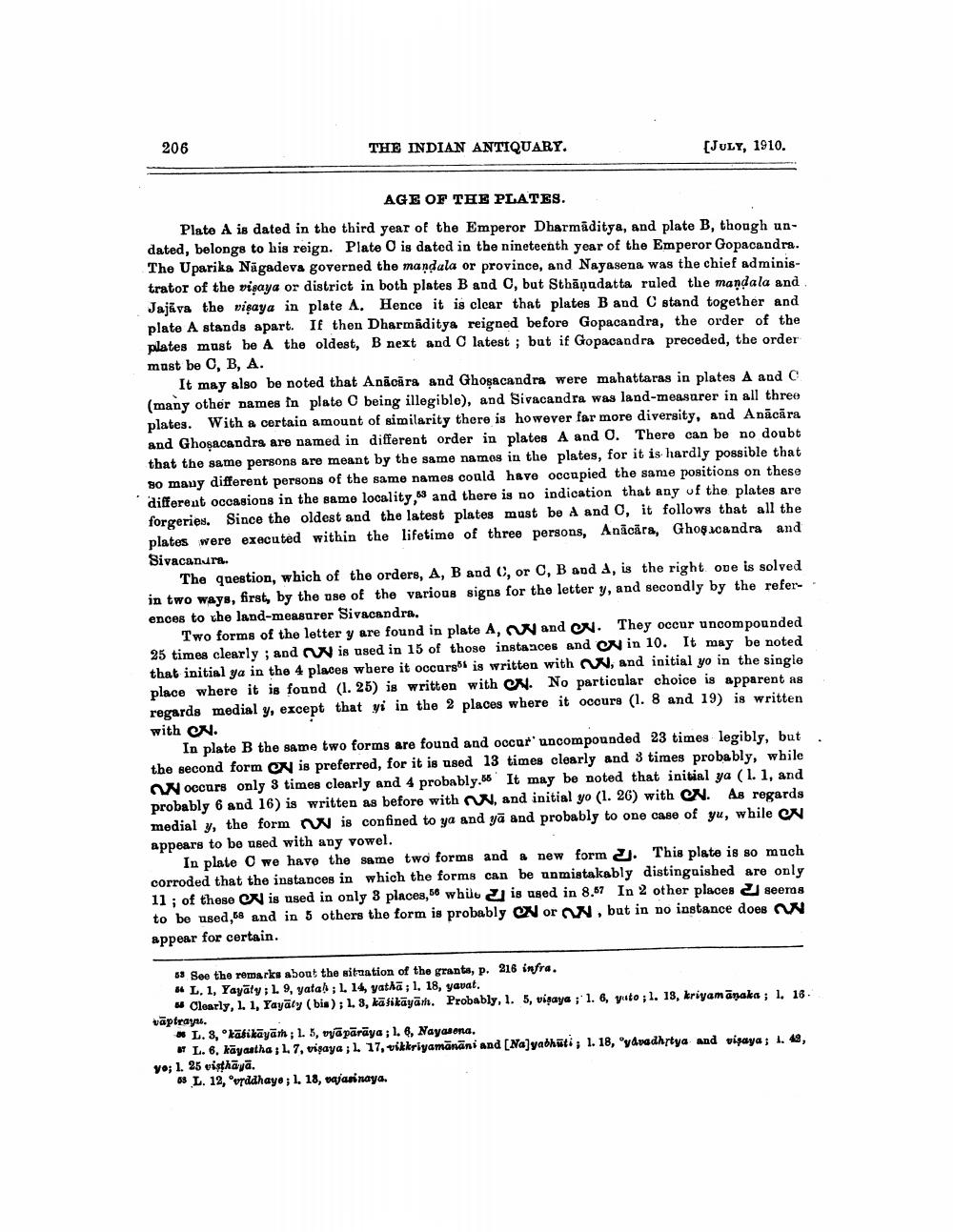________________
206
THE INDIAN ANTIQUARY.
[JULY, 1910.
AGE OF THE PLATES. Plate A is dated in the third year of the Emperor Dharmaditya, and plate B, though undated, belongs to his reign. Plate O is dated in the nineteenth year of the Emperor Gopacandra. The Uparika Nägadeva governed the mandala or province, and Nayasena was the chief administrator of the visaya or district in both plates B and C, but Sthāņudatta ruled the mandala and Jajāva the visaya in plate A. Hence it is clear that plates B and C stand together and plate A stands apart. If then Dharmaditya reigned before Gopacandra, the order of the plates must be A the oldest, B next and latest ; but if Gopacandra preceded, the order must be C, B, A.
It may also be noted that Anācāra and Ghoşacandra were mahattaras in plates A and C (many other names in plato O being illegible), and Sivacandra was land-measurer in all three plates. With a certain amount of similarity there is however far more diversity, and Anācāra and Ghosacandrs are named in different order in plates A and O. There can be no doubt that the same persons are meant by the same names in the plates, for it is hardly possible that 80 many different persons of the same names could have occupied the same positions on these different occasions in the same locality, and there is no indication that any of the plates are forgeries. Since the oldest and the latest plates must be A and o, it follows that all the plates were executed within the lifetime of three persons, Anācāra, Ghoscandra and Sivacanura.
The question, which of the orders, A, B and C, or C, B and A, is the right one is solved in two ways, first, by the use of the various signs for the letter y, and secondly by the refer-- ences to the land-measurer Sivacandra.
Two forms of the letter y are found in plate A, N and on. They occur uncompounded 25 times clearly; and is used in 15 of those instances and in 10. It may be noted that initial ya in the 4 places where it occargl is written with W, and initial yo in the single place where it is found (1. 25) is written with N. No particular choice is apparent as regards medial y, except that vi in the 2 places where it occurs (1. 8 and 19) is written with N.
In plate B the same two forms are found and occur' uncompounded 23 times legibly, but. the second form is preferred, for it is used 13 times clearly and 3 times probably, while
occurs only 3 times clearly and 4 probably.56' It may be noted that initial ya (1. 1, and probably 6 and 16) is written as before with , and initial yo (1. 26) with N. As regards medial y, the form is confined to ya and yā and probably to one case of yu, while e appears to be used with any vowel.
In plate O we have the same two forms and a new form 3. This plate is so much corroded that the instances in which the forms can be unmistakably distinguished are only 11 ; of these is used in only 3 places, 66 while J is used in 8.57 In 2 other places seeras to be used,68 and in 5 others the form is probably Nor , but in no instance does appear for certain.
53 See the remarks about the situation of the grants, p. 216 infra. ** L. 1, Yayāty; l. 9, yatah; 1. 14, yathā; 1. 18, yavat.
w Clearly, 1. 1, Yayāty (bia); 1. 3, kā likāyām. Probably, 1. 5, vigaya ;' 1. 6, yuto; l. 13, kriyamānaka ; 1. 18. vāptrays.
L. 8, kakikāyān: 1. 5, vyāpārāya; 1. , Nayasona. * L. 6. kāyaatha; 1. 7, visaya; L 17, vikkriyamānäni and [Na]yabhūti; 1. 18, "yavadhrtya and visaya; 1. 49, yo; 1. 25 visthāyā.
L. 12,vrddhay® ; 1. 18, oqjaninaya.




